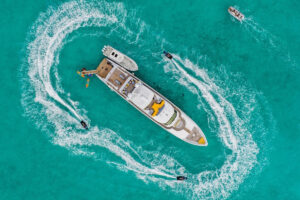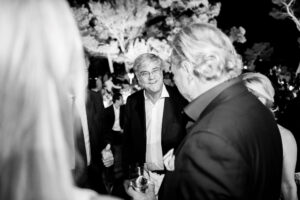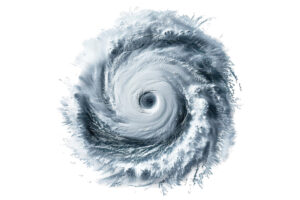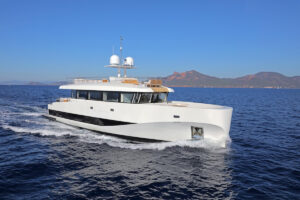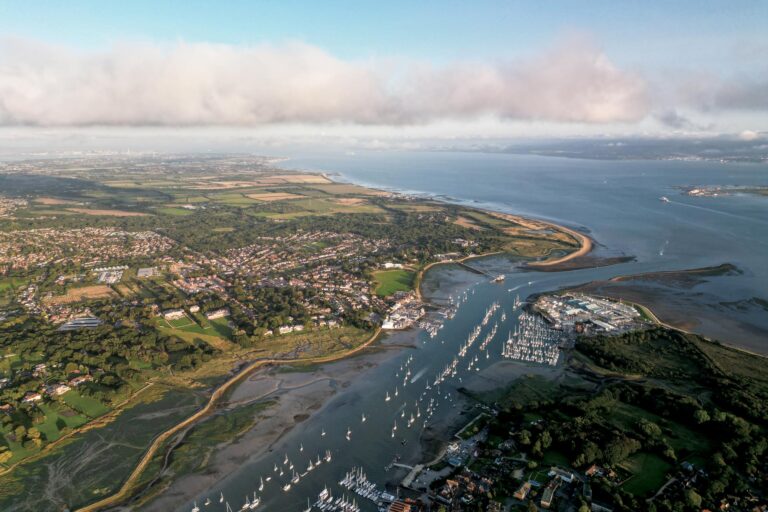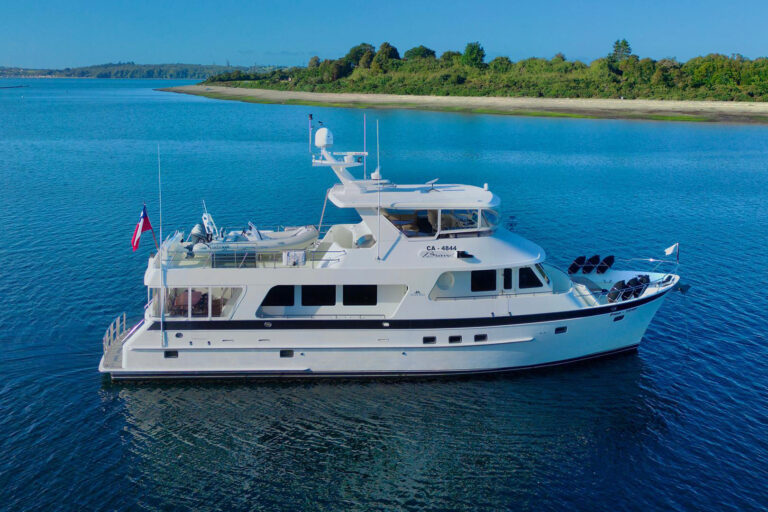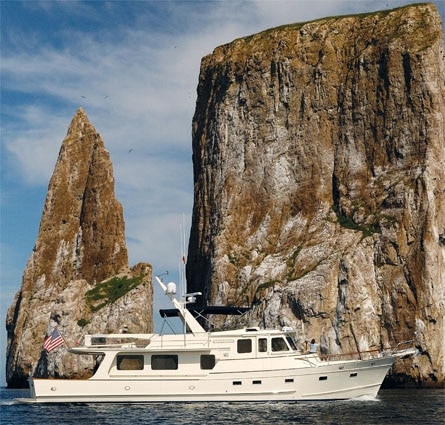
Galapagosaltcoverb
The fresh scent of ocean air flowing through my cabin’s open port and the hushed sound of the solid hull slicing through the gentle swells filled me with the familiar sense of peace that offshore passages often bring. Looking out at the moonless night, large white gulls escorting our little ship were tinted green from our starboard running light, and I knew their presence meant we were nearing landfall. But this ocean passage and the land ahead were like no others. We were en route to the Galápagos Islands for the excursion of a lifetime.
I had joined Tony Fleming (founder and president of Fleming Yachts) and his crew of two aboard Venture, his Fleming 65, at the Los Sueños Marina and Resort in Costa Rica. He had decided to make this 1,900-mile side trip to explore the Galápagos before transiting the Panama Canal on his Alaska-to-Newfoundland “voyage of personal discovery,” as he likes to call his latest adventure.
Our plan was to head 300 miles south-southwest to Isla del Coco, a large, uninhabited island that is part of a Costa Rican national park. From there we would continue another 400 miles to the southern tip of Santa Cruz, one of the larger inhabited Galápagos Islands, and then onto our 300-mile exploration of the archipelago made famous by Charles Darwin.
Venture, a twin-engine, pilothouse yacht, carries 1,700 gallons of diesel, and while she can cruise in the high teens, we would run her between 8 and 9 knots while burning 10 to 12 gallons per hour. Fleming had arranged to buy fuel in the Galápagos through Naugala, a Galápagos yacht services company (see “Call of The Wild,” July 2008), as Venture’s tanks would need to be topped off for the 900-mile passage to Panama.
The 31-hour voyage to Isla del Coco was uneventful, giving the four of us time to adjust to our offshore routine. Fleming’s captain, Chris Conklin, established a watch schedule of 2 hours on and 6 hours off for the four of us. Since we had a straight course for nearly 300 miles, standing watch took on the literal meaning of simply watching for traffic, watching the boat’s icon follow our plotted course on the Nobeltec display, and watching the MAN electronic engine instruments for any deviations.
The wind was mostly on our nose, blowing 10 to 15 knots, and the seas were described as both “lumpy” and “bumpy” in our log. Freighter traffic heading to and from Panama disappeared once we were 40 miles off the coast of Costa Rica, and the only targets on our radar were the constant rain squalls we experienced along our route. The sight of Isla del Coco in late afternoon during a heavy downpour was a bit eerie, as low clouds surrounded its lush green, mountainous peak and our imaginations stirred visions of a lost world. Indeed, the island was reportedly the inspiration for Daniel Defoe’s Robinson Crusoe as well as Michael Crichton’s Jurassic Park.
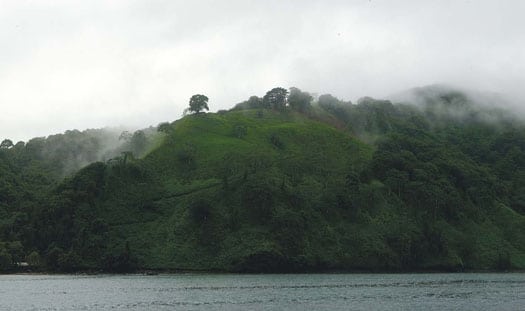
| | |
Now part of Costa Rica’s National Park, this nine-square-mile island is inhabited only by a couple dozen park rangers and is visited mostly by excursion dive boats from the mainland. Called “the most beautiful island in the world” by Jacques Cousteau, its coral reefs and volcanic caves and tunnels are populated by hundreds of species of fish, including large numbers of hammerhead sharks. But its challenging currents and severe dropoffs are for experienced divers only.
Until a 125-foot Palmer Johnson sailing yacht en route from Panama dropped anchor in the middle of the night, the only other boats in the Chatham Bay anchorage were two dive boats. We were definitely off the beaten track.
As scheduled, a ranger visited us early the next day and entertained us with a professionally produced DVD presentation of the island. While collecting the $25 per person per day visiting fee ($10 extra if diving) and a $35 mooring fee, he explained the challenges the government is having with illegal fishing of its waters. The growing worldwide demand for seafood, and in particular shark fins, is taxing Costa Rica’s ability to enforce its environmental laws and protect its natural resources. Our visitor’s fee was a small price to pay for the privilege of seeing such an unspoiled, natural habitat, and we hope it will in some way contribute to the park rangers’ battle with illegal poachers.
Since none of us are avid divers, he suggested we hike to the top of the waterfall in Wafer Bay, and he radioed the ranger station to arrange for a guide to take us there. The trek was less than 2 miles from where we landed our dinghy on the beach to the waterfall, but it was uphill all the way through a thick rainforest with unsure footing. The forest was alive with wildlife and exotic sounds, and the hot humid air had us stopping frequently to catch our breath and rehydrate. After an hour and a half we reached the top, ready for a cool, refreshing swim under the falls.
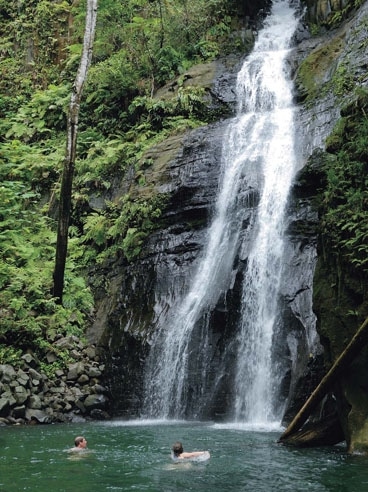
| | |
We knew Isla del Coco was merely a warm-up for what we would discover in the Galápagos, and so we weighed anchor the next morning with eager anticipation, plotting our 411-mile course for Academy Bay in Santa Cruz. The winds continued at 10 to 15 knots SSW, the seas were a friendly 2 to 3 feet on top of large, gentle swells, and we again adjusted to our passagemaking mode.
Two days and two nights after we left we arrived in Port Ayora in the southern part of Santa Cruz and were immediately struck by all the activity in the harbor. The sight of small freighters, mini-cruise ships, large dive boats, small tour boats and private sailing yachts was in conflict with our perception that the Galápagos were cut off from the rest of the world. This is a busy port with thousands of tourists passing through each month.
Here we met Johnny Romero of Naugala, the agent Fleming had hired to coordinate our 10-day excursion, and Patricia Stucki, our guide who would join us onboard, providing us with endless facts about the islands and their wildlife. We soon learned we would be following a rigid itinerary that had been approved by the National Park Service and from which we could not deviate. The Ecuadorian government was serious about limiting both the number of locations that could be visited and the number of people that could visit each location.
We began our Galápagos adventure the next day anchored between two tiny islands known as Plaza Sur off the northeast coast of Santa Cruz. Conklin landed us on the rocky shore, where we competed for walking space with a dozen or so sea lions. Landing a dinghy is not allowed in the islands other than to drop someone off, so we took turns driving the Zodiac throughout our trip to give everyone a chance to explore.
Once past the sea lions we followed the marked path around the island, with Stucki warning us to stay within the markers-again an attempt to minimize the impact of visitors.
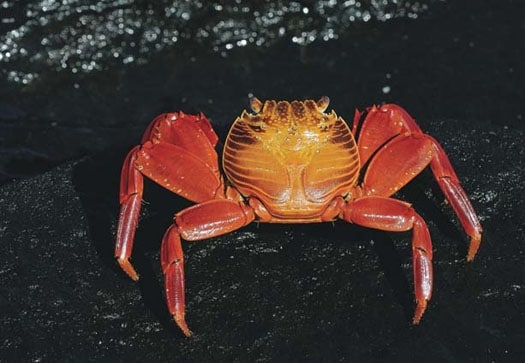
| | |
But we never felt out of touch with the wildlife, as we quickly discovered how utterly fearless the local habitants are when faced with human contact. Within seconds of our landing, Fleming, an avid videographer, and I were overwhelmed by the photo opportunities surrounding us. Look one way, and there was a sea lion staring at you. Look down, and a land iguana was crossing your path. Look up and a pelican was skydiving for a snack. Take another few steps and you’d see marine iguanas basking in the sun, waiting to take their afternoon swim.
And this was just the beginning. There would be blue-footed booby birds, sally lightfoot crabs, red-ballooned frigate birds, fur seals, giant land tortoises, sea turtles, whitetip sharks, Darwin finches, and even the rare Galápagos penguin-all of which seemed to be calmly watching us as if we didn’t matter.
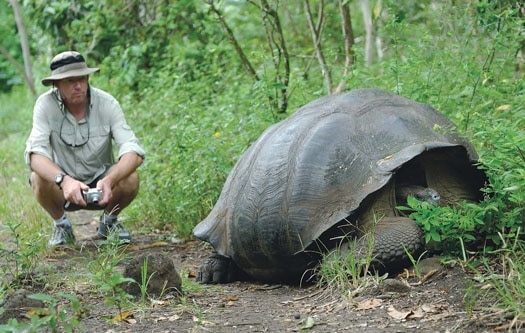
| | |
During our 10-day guided exploration we visited the islands of Santa Cruz, San Cristobol, Española, Santa Maria, Isabela, San Salvador, and Baltra, covering a distance of 300 miles. Each island was totally different, and each presented a unique landscape with its own distinct wildlife. Some islands, like San Cristobol, offered dramatically varied landscapes that included white, sandy beaches, jet black lava flows, high cliffs of red rock and struggling vegetation, all surrounded by aqua-blue water teeming with marine life.
Landing on the lava rocks in Sullivan Bay on San Salvador, on the other hand, was like landing on the moon. Spectacular shapes and patterns of cooled, black lava stretched before us for miles, creating a hostile landscape and making us wonder what it must have been like during its eruption just 100 years ago.
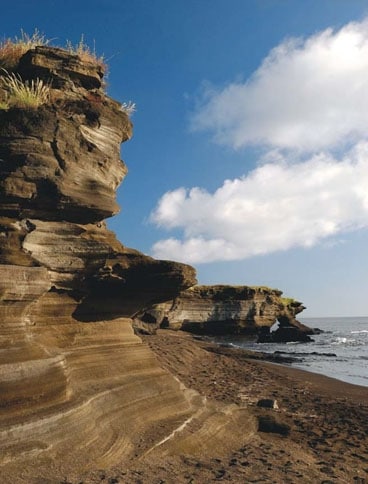
| | |
Throughout our 300-mile exploration we saw very few private yachts except for those in Academy Bay, where most of the island tours begin. This suggests that most visitors, even those who have arrived in their own boat, hire a local tour boat or cruise ship to see the islands. These boats usually travel at night, giving their passengers time to see the sights on land in daylight. But because there are few navigational aides and even the latest electronic charts are not entirely accurate, there is a risk to those without local knowledge traveling at night.
We experienced other cruising challenges as well. Within two days we severely damaged two of our three anchors when they got caught under large rocks and were bent so badly they were useless. Some anchorages were in water deeper than 100 feet, requiring at least 400 feet of chain. Other anchorages had us literally between a rock and a hard place with little swinging room, and on one occasion we were awakened by the sickening sound of surf. An unexpected wind shift had caused us to get perilously close to a ledge, and we found it necessary to move in the middle of the night.
Challenges and risks are, however, all part of cruising, and the rewards of experiencing such a voyage will be with us forever. Fortunately, Fleming had hired an excellent agent who took care of all the details of dealing with the local regulations, arranged for the purchase of over 1,500 gallons of fuel, and provided us with a knowledgeable, friendly guide-Stucki got along so well with Fleming and his crew that she stayed aboard for the passage to Panama.
Venture, on which Tony Fleming cruises extensively, testing new ideas and gear for his three models, was an ideal platform to discover the wonders of this world. The Galápagos have been on my list of places to see ever since I picked up a serious camera. Seeing them through the viewfinder from the decks of a well-found cruising yacht made this the adventure of a lifetime.

